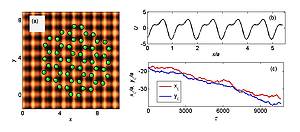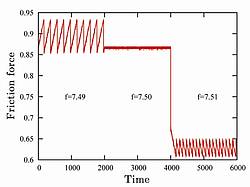Rotary motors sliding along surfaces (9 March 2009)

We introduce a family of molecular rotors that may convert light or chemical energy into directed translational motion along surfaces.
The dependencies of diffusion coefficient and drift velocity of the rotating molecule on the magnitude of external torque, symmetry of surface potential, and temperature have been investigated. Our simulations show that the rotation-translation coupling could be very effective, and the molecule may move by approximately one surface lattice spacing per complete rotation. We have found that the unidirectionality of the rotary motion is not required to produce efficient directed sliding; this effect can be achieved by applying a time-periodic, or even randomly, oscillating torque which induces alternating molecular reorientations but does not generate complete rotations
This results have been published in Phys. Rev. E. 2009, 79, 021108
Controlling microscopic friction through mechanical oscillations (20 November 2008)
 |
Researchers from the Universities Modena Reggio Emilia and Tel Aviv from the ACOF collaborative Research Project explore a novel approach for tuning interface friction properties. They show that by applying external vibrations, either in-plane or out-of the plane, friction due to dissipative mechanisms can be reduced. When subject to external mechanical solicitation, particles at the interface acquire sufficient energy to overcome the local potential minima thus increasing their diffusion and mobility and reducing friction. The critical parameters are the frequency and the amplitude of the oscillations which can be continuously tuned to obtain desired properties and motion regimes from highly dissipative “stick-slip” to smooth sliding. The model has been applied to an Atomic Force Miscroscope (AFM) tip moving on an oscillating substrate and numerical simulations have been carried out showing that for a carefully chosen set of parameters friction almost vanishes.
These results have recently appeared in Physical Review E 78, 036110 (2008) and selected by the Virtual Journal of Nanoscale Science and Technology 18 (12) (2008).

